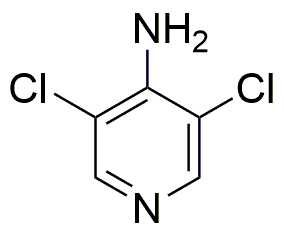4-Amino-3,5-dichloropyridine is widely utilized in research focused on:
- Pesticide Development: This compound serves as an important intermediate in the synthesis of various agrochemicals, particularly herbicides and insecticides, helping to enhance crop protection.
- Pharmaceuticals: It is used in the development of pharmaceutical agents, contributing to the formulation of drugs that target specific diseases, particularly in the field of anti-infectives.
- Material Science: The compound is employed in the creation of specialty materials, including polymers and coatings, which benefit from its unique chemical properties.
- Research Reagents: As a versatile reagent, it is utilized in various chemical reactions and studies, aiding researchers in synthesizing other complex compounds.
- Biochemical Applications: It plays a role in biochemical assays and studies, particularly in understanding enzyme interactions and metabolic pathways.
General Information
Properties
Safety and Regulations
Applications
4-Amino-3,5-dichloropyridine is widely utilized in research focused on:
- Pesticide Development: This compound serves as an important intermediate in the synthesis of various agrochemicals, particularly herbicides and insecticides, helping to enhance crop protection.
- Pharmaceuticals: It is used in the development of pharmaceutical agents, contributing to the formulation of drugs that target specific diseases, particularly in the field of anti-infectives.
- Material Science: The compound is employed in the creation of specialty materials, including polymers and coatings, which benefit from its unique chemical properties.
- Research Reagents: As a versatile reagent, it is utilized in various chemical reactions and studies, aiding researchers in synthesizing other complex compounds.
- Biochemical Applications: It plays a role in biochemical assays and studies, particularly in understanding enzyme interactions and metabolic pathways.
Documents
Safety Data Sheets (SDS)
The SDS provides comprehensive safety information on handling, storage, and disposal of the product.
Product Specification (PS)
The PS provides a comprehensive breakdown of the product’s properties, including chemical composition, physical state, purity, and storage requirements. It also details acceptable quality ranges and the product's intended applications.
Certificates of Analysis (COA)
Search for Certificates of Analysis (COA) by entering the products Lot Number. Lot and Batch Numbers can be found on a product’s label following the words ‘Lot’ or ‘Batch’.
*Catalog Number
*Lot Number
Certificates Of Origin (COO)
This COO confirms the country where the product was manufactured, and also details the materials and components used in it and whether it is derived from natural, synthetic, or other specific sources. This certificate may be required for customs, trade, and regulatory compliance.
*Catalog Number
*Lot Number
Safety Data Sheets (SDS)
The SDS provides comprehensive safety information on handling, storage, and disposal of the product.
DownloadProduct Specification (PS)
The PS provides a comprehensive breakdown of the product’s properties, including chemical composition, physical state, purity, and storage requirements. It also details acceptable quality ranges and the product's intended applications.
DownloadCertificates of Analysis (COA)
Search for Certificates of Analysis (COA) by entering the products Lot Number. Lot and Batch Numbers can be found on a product’s label following the words ‘Lot’ or ‘Batch’.
*Catalog Number
*Lot Number
Certificates Of Origin (COO)
This COO confirms the country where the product was manufactured, and also details the materials and components used in it and whether it is derived from natural, synthetic, or other specific sources. This certificate may be required for customs, trade, and regulatory compliance.


